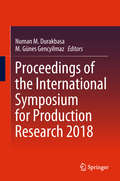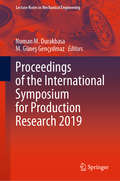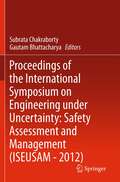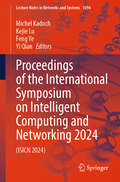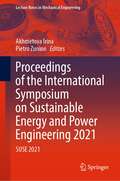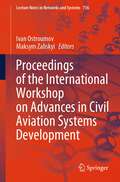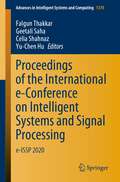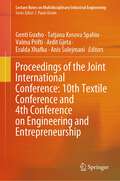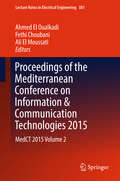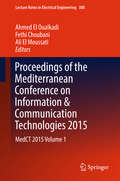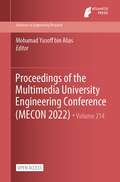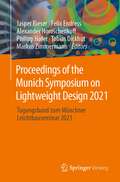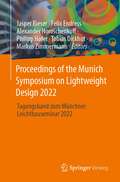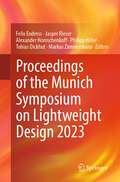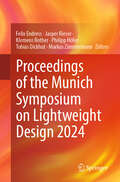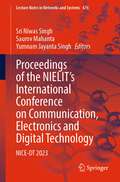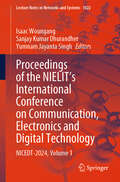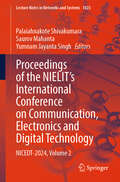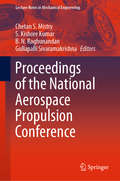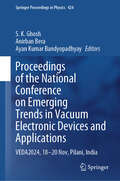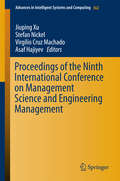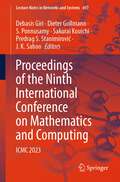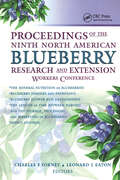- Table View
- List View
Proceedings of the International Symposium for Production Research 2018
by Numan M. Durakbasa M. Günes GencyilmazThe conference aims at forming a unique platform to bring together academicians and practitioners from industrial engineering and management engineering as well as from other disciplines working on production function applying the tools of operational research and production/operational management. Topics treated include: computer aided manufacturing, industry 4.0, big data and analytics, flexible manufacturing systems, fuzzy logic, industrial applications, information technologies in production management, optimization, production economy, production planning and control, productivity and performance management, project management, quality management, risk analysis and management, supply chain management.
Proceedings of the International Symposium for Production Research 2019 (Lecture Notes in Mechanical Engineering)
by Numan M. Durakbasa M. Güneş GençyılmazThis book discusses the conference that forms a unique platform to bring together academicians and practitioners from industrial engineering and management engineering as well as from other disciplines working on production function applying the tools of operational research and production/operational management. Topics treated include: computer-aided manufacturing, Industry 4.0, big data and analytics, flexible manufacturing systems, fuzzy logic, industrial applications, information technologies in production management, optimization, production economy, production planning and control, productivity and performance management, project management, quality management, risk analysis and management, and supply chain management
Proceedings of the International Symposium on Engineering under Uncertainty: Safety Assessment and Management (ISEUSAM - #2012)
by Gautam Bhattacharya Subrata ChakrabortyInternational Symposium on Engineering under Uncertainty: Safety Assessment and Management (ISEUSAM - 2012) is organized by Bengal Engineering and Science University, India during the first week of January 2012 at Kolkata. The primary aim of ISEUSAM 2012 is to provide a platform to facilitate the discussion for a better understanding and management of uncertainty and risk, encompassing various aspects of safety and reliability of engineering systems. The conference received an overwhelming response from national as well as international scholars, experts and delegates from different parts of the world. Papers received from authors of several countries including Australia, Canada, China, Germany, Italy, UAE, UK and USA, besides India. More than two hundred authors have shown their interest in the symposium. The Proceedings presents ninety two high quality papers which address issues of uncertainty encompassing various fields of engineering, i.e. uncertainty analysis and modelling, structural reliability, geotechnical engineering, vibration control, earthquake engineering, environmental engineering, stochastic dynamics, transportation system, system identification and damage assessment, and infrastructure engineering.
Proceedings of the International Symposium on Intelligent Computing and Networking 2024: (ISICN 2024) (Lecture Notes in Networks and Systems #1094)
by Yi Qian Feng Ye Michel Kadoch Kejie LuInternational Symposium on Intelligent Computing and Networking 2024 (ISICN 2024), March 18-20, 2024; San Juan, Puerto Rico. Intelligent computing and networking is a rapidly growing area that has attracted significant attention due to its potential impact on the quality of service of applications for B5G/6G networks and the future Internet. To enable intelligent computing and networking, it is necessary to integrate technologies from the fields of communications, networking, computing, artificial intelligence, and numerous other fields. The scope of the symposium covers all enabling technologies for intelligent computing and networking. This book includes a huge variety of topics ranging from communications, computing, and networking to services and applications of artificial intelligence. Intended readership includes engineers and researchers in artificial intelligence, intelligent computing and networking areas. Targeted primary market will be professors, graduate students, and senior undergraduate students as well as research engineers. Targeted secondary market will be industry managers, consultants, and government research agencies in the related fields.
Proceedings of the International Symposium on Lightweight and Sustainable Polymeric Materials (Springer Proceedings in Materials #32)
by Suchart Siengchin Sanjay Mavinkere RangappaThis proceedings book contains papers presented at the International Symposium on Lightweight and Sustainable Polymeric Materials (LSPM23) held on February 17, 2023, and organized by King Mongkut’s University of Technology North Bangkok, Thailand. The papers in this book are presented by academics and industrial practitioners showcasing the latest technological advancements and applications of environmentally friendly polymeric materials with the emphasis on the production of lightweight, low-cost, low-energy-consuming materials with competitive performance. The content of this book appeals to academia and industrial researchers from the fields of polymer chemistry, physics, and materials science.
Proceedings of the International Symposium on Sustainable Energy and Power Engineering 2021: SUSE 2021 (Lecture Notes in Mechanical Engineering)
by Akhmetova Irina Pietro ZuninoThis book comprises the proceedings of the International Symposium on Sustainable Energy and Power Engineering (SUSE) 2021. The contents of this volume focus on recent technological advances in the field of energy efficiency and green buildings, new construction materials and related technology, hydrogen and renewable energy, environmental aspects of the modern power industry, etc. The contents cover latest advances especially in digital transformation of society and economy of the energy sector, turbomachines and combined plants, intelligent energy systems. This volume will prove a valuable resource for those in academia and industry.
Proceedings of the International Workshop on Advances in Civil Aviation Systems Development (Lecture Notes in Networks and Systems #736)
by Ivan Ostroumov Maksym ZaliskyiThis book includes high-quality research papers presented at International Workshop on Advances in Civil Aviation Systems Development (ACASD 2023), which was at National Aviation University, Kyiv Ukraine, on May 30, 2023. This book presents original results of a scholarly study of unique research teams and market leaders on the development in civil aviation systems and its application. The book topics include major research areas focused on advances in avionics system design, modern trends in communication, surveillance and navigation systems development, and civil avionics system maintenance questions. Also, proposed book is useful for scholars and professionals in the civil aviation domain.
Proceedings of the International e-Conference on Intelligent Systems and Signal Processing: e-ISSP 2020 (Advances in Intelligent Systems and Computing #1370)
by Yu-Chen Hu Falgun Thakkar Geetali Saha Celia ShahnazThis book provides insights into the Third International Conference on Intelligent Systems and Signal Processing (eISSP 2020) held By Electronics & Communication Engineering Department of G H Patel College of Engineering & Technology, Gujarat, India, during 28–30 December 2020. The book comprises contributions by the research scholars and academicians covering the topics in signal processing and communication engineering, applied electronics and emerging technologies, Internet of Things (IoT), robotics, machine learning, deep learning and artificial intelligence. The main emphasis of the book is on dissemination of information, experience and research results on the current topics of interest through in-depth discussions and contribution of researchers from all over world. The book is useful for research community, academicians, industrialists and postgraduate students across the globe.
Proceedings of the Joint International Conference: 10th Textile Conference and 4th Conference on Engineering and Entrepreneurship (Lecture Notes on Multidisciplinary Industrial Engineering)
by Genti Guxho Tatjana Kosova Spahiu Valma Prifti Ardit Gjeta Eralda Xhafka Anis SulejmaniThis proceedings book encompass a wide range of significant topics within the realms of Technologies, Engineering, Management, and Production, Entrepreneurship, Materials, Textiles, Fashion, and more. The book delves into various areas of Energetics, exploring aspects such as power production, solar power, wind turbines, advanced energetics technologies, energy resource efficiency, global warming and emissions, clean and renewable energies, as well as economic development, global warming, and environmental protections. The Constructions and Transport section features discussions on numerical methods for data manipulation, construction science and technology, transport systems, modeling of transport systems, intelligent transport, traffic management and safety. The Materials segment addresses materials science and application, biopolymers and biotechnology, metallic and composite materials, metallurgical engineering, recycling, manufacturing, and processing of various materials such as paper, plastics, rubber, glass, ceramics, and more. Management and Production topics include technology management, logistic and supply chain management, total quality management, knowledge and innovation management, financial management, marketing research and strategy, industrial marketing, operational research, project management, as well as information technology in enterprises, e-activities, and e-commerce. The book also features an extensive section dedicated to Textiles, covering textile processing and testing, technological advances in the textile industry, ecology and environment in textile production, fiber physics and textile mechanics, finishing, dyeing, and treatment techniques, modeling and simulation, smart and interactive textiles, technical and protective textiles, textile design, fashion, and garment manufacturing, innovations in textile education, as well as leather and footwear technologies.
Proceedings of the Materials Forum 2007: Corrosion Education for the 21st Century
by National Research Council of the National AcademiesThe National Academies Press (NAP)--publisher for the National Academies--publishes more than 200 books a year offering the most authoritative views, definitive information, and groundbreaking recommendations on a wide range of topics in science, engineering, and health. Our books are unique in that they are authored by the nation's leading experts in every scientific field.
Proceedings of the Mediterranean Conference on Information & Communication Technologies 2015
by Ahmed El Oualkadi Fethi Choubani Ali El MoussatiThis volume presents the second part of the proceedings of the MediterraneanConference on Information & Communication Technologies (MedICT 2015), whichwas held at Saidia, Morocco during 7-9 May, 2015. MedICT provides an excellentinternational forum to the researchers and practitioners from both academia aswell as industry to meet and share cutting-edge development. The conference hasalso a special focus on enabling technologies for societal challenges, andseeks to address multidisciplinary challenges in Information &Communication Technologies such as health, demographic change, wellbeing,security and sustainability issues. The proceedings publish high quality papers which are closely related tothe various theories, as well as emerging and practical applications ofparticular interest to the ICT community. This second volume provides a compact yet broad view of recentdevelopments in Data, Systems, Servicesand Education, and covers recent research areas in the field including ControlSystems, Software Engineering, Data Mining and Big Data, ICT for Education andSupport Activities, Networking, Cloud Computing and Security, ICT BasedServices and Applications, Mobile Agent Systems, Software Engineering, DataMining and Big Data, Online Experimentation & Artificial Intelligence inEducation, Networking, Cloud Computing and Security, ICT Based Education andServices ICT Challenges and Applications, Advances in ICT Modeling and DesignICT Developments.
Proceedings of the Mediterranean Conference on Information & Communication Technologies 2015
by Ahmed El Oualkadi Fethi Choubani Ali El MoussatiThis volume presents the second part of the proceedings of the MediterraneanConference on Information & Communication Technologies (MedICT 2015), whichwas held at Saidia, Morocco during 7-9 May, 2015. MedICT provides an excellentinternational forum to the researchers and practitioners from both academia aswell as industry to meet and share cutting-edge development. The conference hasalso a special focus on enabling technologies for societal challenges, andseeks to address multidisciplinary challenges in Information &Communication Technologies such as health, demographic change, wellbeing,security and sustainability issues. The proceedings publish high quality papers which are closely related tothe various theories, as well as emerging and practical applications ofparticular interest to the ICT community. This second volume provides a compact yet broad view of recentdevelopments in Data, Systems, Servicesand Education, and covers recent research areas in the field including ControlSystems, Software Engineering, Data Mining and Big Data, ICT for Education andSupport Activities, Networking, Cloud Computing and Security, ICT BasedServices and Applications, Mobile Agent Systems, Software Engineering, DataMining and Big Data, Online Experimentation & Artificial Intelligence inEducation, Networking, Cloud Computing and Security, ICT Based Education andServices ICT Challenges and Applications, Advances in ICT Modeling and DesignICT Developments.
Proceedings of the Multimedia University Engineering Conference (Advances in Engineering Research #214)
by Mohamad Yusoff bin AliasThis is an open access book.The Multimedia University Engineering Conference 2022 (MECON 2022) aims to bring together related research scholars, educators, practitioners, policy makers, enthusiasts, fellow students, and industries to share and exchange their research experiences and results on all aspects of engineering technologies from various perspectives, disciplines, and fields. It also offers an interdisciplinary platform for all stakeholders to present and discuss the most latest trends, innovations, and concerns as well as practical challenges encountered, and solutions adopted in the realm of engineering technologies. This conference is being co-organised by the Faculty of Engineering (FOE) and Faculty of Engineering and Technology (FET), Multimedia University. MECON 2022 carries the theme `Sustainable Engineering for a Sustainable Future’.
Proceedings of the Munich Symposium on Lightweight Design 2021: Tagungsband zum Münchner Leichtbauseminar 2021
by Alexander Horoschenkoff Philipp Höfer Markus Zimmermann Jasper Rieser Felix Endress Tobias DickhutEvery year, the Technical University of Munich, the Universität der Bundeswehr München, and the University of Applied Sciences in Munich invite researchers and practitioners to join the Munich Symposium on Lightweight Design. Experts from industry and academia discuss design tools, applications, and new developments. Topics include, e.g., composite structures, SHM, microstructures, material modelling, design for additive manufacturing, numerical optimization and in particular topology optimization in aerospace, automotive and other industries. The talks are summarized in short articles and presented in this volume.
Proceedings of the Munich Symposium on Lightweight Design 2022: Tagungsband zum Münchner Leichtbauseminar 2022
by Alexander Horoschenkoff Philipp Höfer Markus Zimmermann Jasper Rieser Felix Endress Tobias DickhutEvery year, the Technical University of Munich, the Universität der Bundeswehr München, and the University of Applied Sciences in Munich invite researchers and practitioners to join the Munich Symposium on Lightweight Design. Experts from industry and academia discuss design tools, applications, and new developments. Topics include, e.g., composite structures, SHM, microstructures, material modelling, design for additive manufacturing, numerical optimization and in particular topology optimization in aerospace, automotive and other industries. The talks are summarized in short articles and presented in this volume.
Proceedings of the Munich Symposium on Lightweight Design 2023
by Alexander Horoschenkoff Philipp Höfer Markus Zimmermann Jasper Rieser Felix Endress Tobias DickhutThis book includes topics like composite structures, SHM, microstructures, material modelling, design for additive manufacturing, numerical optimization and in particular topology optimization in aerospace, automotive, and other industries. Every year, the Technical University of Munich, the Universität der Bundeswehr München, and the University of Applied Sciences in Munich invite researchers and practitioners to join the Munich Symposium on Lightweight Design. Experts from industry and academia discuss design tools, applications, and new developments. The talks are summarized in short articles and presented in this volume.
Proceedings of the Munich Symposium on Lightweight Design 2024
by Philipp Höfer Markus Zimmermann Jasper Rieser Felix Endress Tobias Dickhut Klemens RotherThis book covers a wide range of topics including structural optimization, composite structures, structural health monitoring, material modeling, and design for additive manufacturing. It places particular emphasis on numerical and topology optimization across sectors such as aerospace, automotive, and other industries. Every year, the Technical University of Munich, the Universität der Bundeswehr München, and the University of Applied Sciences in Munich invite researchers and practitioners to join the Munich Symposium on Lightweight Design. Experts from industry and academia discuss design tools, applications, and new developments. The talks are summarized in short articles and presented in this volume.
Proceedings of the NIELIT's International Conference on Communication, Electronics and Digital Technology: NICE-DT 2023 (Lecture Notes in Networks and Systems #676)
by Sri Niwas Singh Saurov Mahanta Yumnam Jayanta SinghThe book presents selected papers from NIELIT's International Conference on Communication, Electronics and Digital Technology (NICE-DT 2023) held during February 10–11, 2023, in New Delhi, India. The book covers state-of-the-art research insights on artificial intelligence, machine learning, big data, data analytics, cyber security and forensic, network and mobile security, advance computing, cloud computing, quantum computing, VLSI and semiconductors, electronics system, Internet of Things, robotics and automations, blockchain and software technology, digital technologies for future, assistive technology for divyangjan (people with disabilities) and Strategy for Digital Skilling for building a global Future Ready workforce.
Proceedings of the NIELIT's International Conference on Communication, Electronics and Digital Technology: NICEDT-2024, Volume 1 (Lecture Notes in Networks and Systems #1022)
by Isaac Woungang Sanjay Kumar Dhurandher Yumnam Jayanta SinghThe book presents selected papers from NIELIT's International Conference on Communication, Electronics and Digital Technology (NICEDT-2024) held during 16–17 February 2024 in Guwahati, India. The book is organized in two volumes and covers state-of-the-art research insights on artificial intelligence, machine learning, big data, data analytics, cybersecurity and forensic, network and mobile security, advance computing, cloud computing, quantum computing, VLSI and semiconductors, electronics system, Internet of Things, robotics and automations, blockchain and software technology, digital technologies for future, and assistive technology for Divyangjan (people with disabilities).
Proceedings of the NIELIT's International Conference on Communication, Electronics and Digital Technology: NICEDT-2024, Volume 2 (Lecture Notes in Networks and Systems #1023)
by Palaiahnakote Shivakumara Saurov Mahanta Yumnam Jayanta SinghThe book presents selected papers from NIELIT's International Conference on Communication, Electronics and Digital Technology (NICEDT-2024) held during 16–17 February 2024 in Guwahati, India. The book is organized in two volumes and covers state-of-the-art research insights on artificial intelligence, machine learning, big data, data analytics, cybersecurity and forensic, network and mobile security, advance computing, cloud computing, quantum computing, VLSI and semiconductors, electronics system, Internet of Things, robotics and automations, blockchain and software technology, digital technologies for future, and assistive technology for Divyangjan (people with disabilities).
Proceedings of the National Aerospace Propulsion Conference (Lecture Notes in Mechanical Engineering)
by Chetan S. Mistry S. Kishore Kumar B. N. Raghunandan Gullapalli SivaramakrishnaThis volume presents selected papers presented during the National Aerospace Propulsion Conference (NAPC) held at Indian Institute of Technology Kharagpur. It brings together contributions from the entire propulsion community, spanning air-breathing and non-air-breathing propulsion. The papers cover aerospace propulsion-related topics, and discuss relevant research advances made in this field. It will be of interest to researchers in industry and academia working on gas turbine, rocket, and jet engines.
Proceedings of the National Conference on Emerging Trends in Vacuum Electronic Devices and Applications: VEDA2024, 18-20 Nov, Pilani, India (Springer Proceedings in Physics #424)
by S. K. Ghosh Anirban Bera Ayan Kumar BandyopadhyayThis book presents peer reviewed articles from the Conference on Vacuum Electronic Devices Applications (VEDA2024) held at Pilani in India. Like its previous editions, it focusses on new ideas and the latest developments in research and industry on topics like technologies for vacuum electron devices (VEDs) or Systems and Subsystems employing VEDs, RF, HPM, and THz Components, Devices & Systems, RF, MW & mm-wave, Antennas and EM Simulations, Materials, power systems and components for VEDs, High emission density cathodes for VEDs, Applications of VEDs, Future trends & competing technologies. It brings together scientists, industrialists, academicians, and research scholars to exchange ideas and present latest developments in the field.
Proceedings of the Ninth International Conference on Management Science and Engineering Management
by Jiuping Xu Stefan Nickel Virgilio Cruz Machado Asaf HajiyevThis is the Proceedings of the Ninth International Conference on Management Science and Engineering Management (ICMSEM) held from July 21-23, 2015 at Karlsruhe, Germany. The goals of the conference are to foster international research collaborations in Management Science and Engineering Management as well as to provide a forum to present current findings. These proceedings cover various areas in management science and engineering management. It focuses on the identification of management science problems in engineering and innovatively using management theory and methods to solve engineering problems effectively. It also establishes a new management theory and methods based on experience of new management issues in engineering. Readers interested in the fields of management science and engineering management will benefit from the latest cutting-edge innovations and research advances presented in these proceedings and will find new ideas and research directions. A total number of 132 papers from 15 countries are selected for the proceedings by the conference scientific committee through rigorous referee review. The selected papers in the first volume are focused on Intelligent System and Management Science covering areas of Intelligent Systems, Logistics Engineering, Information Technology and Risk Management. The selected papers in the second volume are focused on Computing and Engineering Management covering areas of Computing Methodology, Project Management, Industrial Engineering and Decision Making Systems.
Proceedings of the Ninth International Conference on Mathematics and Computing: ICMC 2023 (Lecture Notes in Networks and Systems #697)
by S. Ponnusamy Debasis Giri Dieter Gollmann Predrag S. Stanimirović Sakurai Kouichi J. K. SahooThis book features selected papers from the 9th International Conference on Mathematics and Computing (ICMC 2023), organized at BITS Pilani K. K. Birla Goa Campus, India, during 6–8 January 2023. It covers recent advances in the field of mathematics, statistics, and scientific computing. The book presents innovative work by leading academics, researchers, and experts from industry in mathematics, statistics, cryptography, network security, cybersecurity, machine learning, data analytics, and blockchain technology in computer science and information technology.
Proceedings of the Ninth North American Blueberry Research and Extension Workers Conference
by Leonard Eaton Charles ForneyImprove yield and quality to give consumers the best blueberries on the market! Proceedings of the 9th North American Blueberry Research and Extension Workers Conference presents the current status of the blueberry industry and recent developments in the biology, breeding, and production of blueberries throughout all of North America. In t
